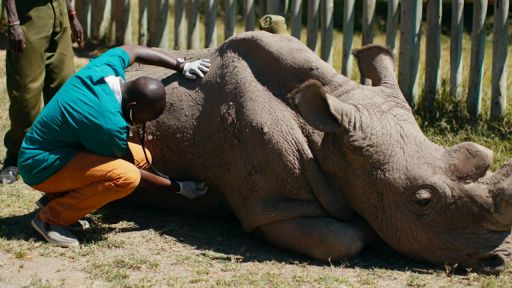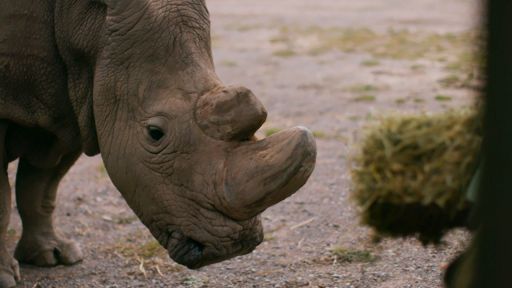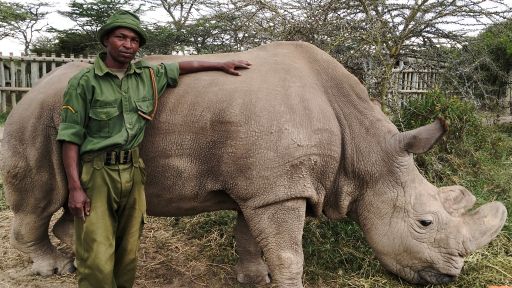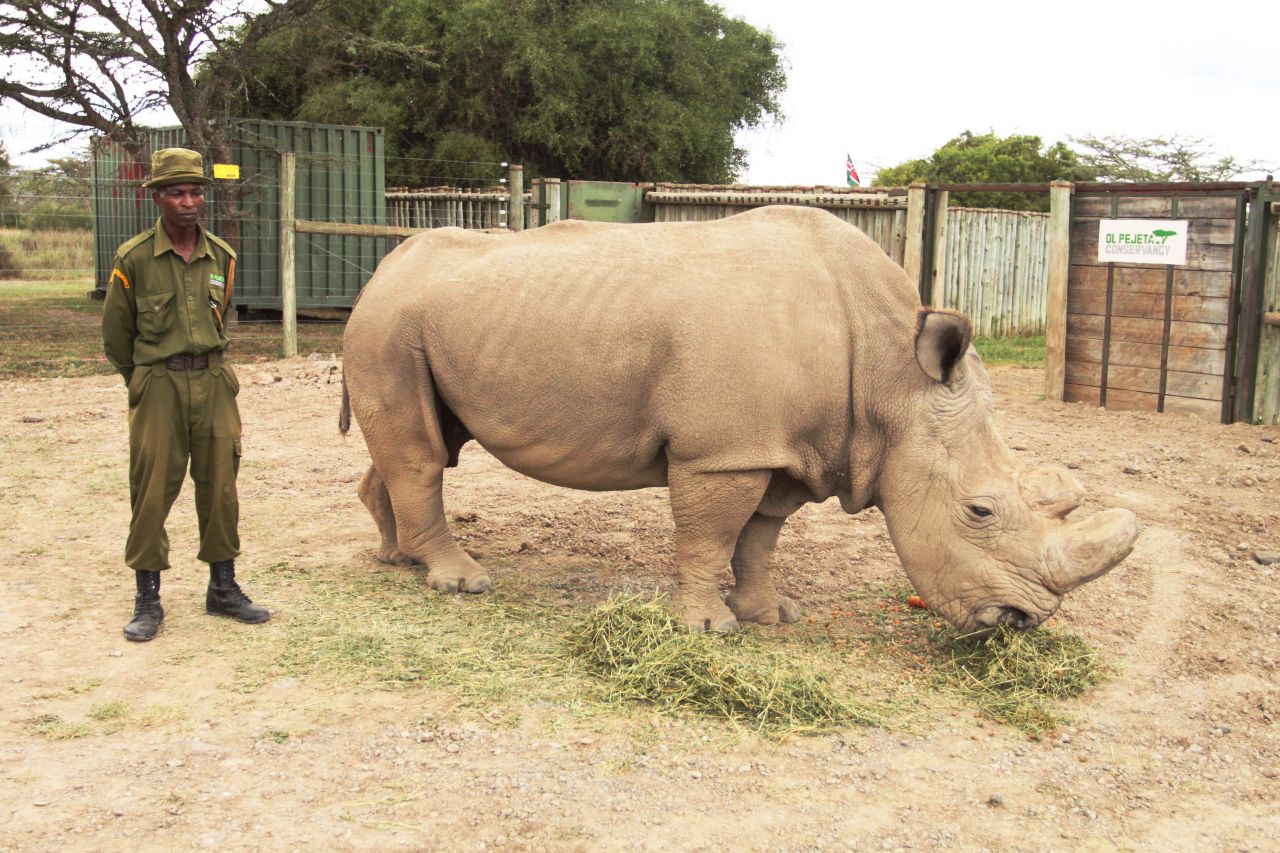
Sudan, the last surviving male northern white rhino. | Credit: Rachel Nuwer
Editor’s Note: Rachel Nuwer received an award from the Society of Environmental Journalists for her coverage of the illegal wildlife trade, which included the article below. You can read more about Rachel’s award and her other work here.
Sudan is the last of his kind on Earth. He just looks like a rhino. But as his keeper will quickly inform you, he is one of just three northern white rhinos remaining on the planet. The other two, a mother-daughter pair named Najin and Fatu, are unable to bear young. In addition to being the last male, Sudan is the only northern white rhino to know what it is like to live in the wild.
Sudan’s demeanor says nothing of the symbolic weight we humans place on his broad, craggy shoulders. When I met him in April at Ol Pejeta Conservancy, his gated home in Kenya, he was munching absentmindedly on a pile of hay. He barely registered the wonder-eyed visitors, alone or in groups of two or three, approached him for photographs. I waited in line and took my turn. Placing a hand on his expansive back, his skin was reminiscent of tree bark. I turned and smiled awkwardly for the camera, unsure whether this should be a celebratory or somber moment. It was hard, after all, not to think of the finality of oblivion in the presence of this placid, blissfully unconcerned creature.
How did it come to this for Sudan and his kind? While the recent upsurge in poaching across Africa has served as the final nail in the northern white rhino’s coffin, the subspecies has been in a precipitous downward spiral for decades, along with other rhino species across Africa and Asia. Humans have always been to blame, decimating habitat and directly killing the animals, most often for their horns, which have been used for everything from Yemeni dagger handles to ingredients in traditional Chinese medicine and party drugs in Vietnam.
Despite the valiant efforts by conservationists, politics, economics, war, greed and market demand ultimately overwhelmed each attempt to save the northern white rhino.
“This isn’t a creature that failed in evolution,” says Thomas Hildebrandt, head of the Department of Reproduction Management at the Leibniz Institute for Zoo and Wildlife Research in Berlin, Germany. “The northern white rhino’s practical extinction is all man made, by poaching and wrong decisions.”
There may be one more chance for the rhino’s future, however. Hildebrandt is a member of an international team of researchers who have dreamed up an enterprising, last-ditch plan to save the northern white rhino from extinction. They will extract eggs from the last females and then fertilize them in the lab using stored sperm from several deceased males. The embryos will then be planted in female southern white rhinos—a closely related subspecies—and carried to term. At the same time, they will pursue cutting edge cellular techniques, transforming stored tissue samples from 12 northern white rhinos into stem cells, which can then be coaxed into becoming sperm and egg cells. Combined, these engineered gametes would introduce enough genetic diversity into Sudan, Fatu and Najin’s descendants to create a healthy population.
Nothing like this has ever been tried before. Some think the plan is naïve, or even foolhardy. But the researchers behind it point out that everything they propose is theoretically possible. What’s more, they see it as their duty to give the subspecies their all. So long as all recovery efforts have not been exhausted, for this dedicated group, giving up is not an option.
Out of Africa
That northern white rhinos exist today at all is largely thanks to a former director of a small zoo in Czechoslovakia. In the 1960s and 70s, Josef Vagner undertook a handful of expeditions to Africa and secured what are likely the largest shipments of wild animals in history. He brought some 3,000 creatures back with him to Europe, 2,000 of which were destined for his zoo, Dvur Kralove, in what is today the Czech Republic. “This wasn’t like spiders or something,” says Jan Stejskal, the zoo’s director of international projects. “Most of these were large ungulates and big mammals.”
Even in the 70s, Vagner was well aware of a “very precious” and exceedingly rare rhino subspecies living in Central Africa. He estimated that just 750 northern white rhinos remained. In 1975, he secured permits to capture six in the country of Sudan—four females and two males—including a calf that he named Sudan.
Under Vagner’s direction, Sudan and the other rhinos settled in nicely at Dvur Kralove’s expansive acres. Vagner collaborated with other European zoos and imported another female in 1977. In 1980, Dvur Kralove welcomed the first northern white rhino ever born in captivity, a male named Suni.
Vagner, however, would not remain for long at the zoo that he loved and built up. He had become a popular figure in society, often featured by the Czech media, his reputation boosted by various awards. But the Czech and Slovak communist authorities that occupied Czechoslovakia at the time viewed this kind of notoriety as a threat, so they began doing what they could to make Vagner’s life difficult. After years of harassment—including the execution of a herd of 49 giraffes—Vagner finally resigned from the zoo’s directorship in 1983. “My father was tired from the chase, and additionally, he had many injuries from his African expeditions,” says Lenka Vagnerova, Vagner’s daughter. “His friends recommended that he leave voluntarily, because sooner or later he would be destroyed by his enemies—and with him, the entire family, too.”
The descendants of the rhinos Vagner collected may turn out to be the subspecies’ saving grace. During the time Vagner was being pushed out by the communists, all evidence pointed toward the collapse of northern white rhino populations in Africa. In 1984, conservationists estimated that only 15 northern white rhinos still existed in the wild, all confined to Garamba National Park in what is now the Democratic Republic of Congo (DRC; formerly known as Zaire). Kes Hillman Smith, a researcher who moved to the park in 1982, turned her attention to identifying, monitoring and protecting the remaining individuals. At first, she and her colleagues succeeded; by 1995, they had brought the rhino’s numbers up to around 35. As she wrote in Garamba, a book she co-edited, “Clearly the habitat was fine for the rhinos and they continued breeding well.”
While Hillman Smith and her colleagues were busy in the field, conservationists elsewhere realized that they needed to make a case for why the northern white rhino was distinct—and thus worthy of saving. Though northern and southern white rhino ranges are separated by thousands of miles and the animals look different—the northern white rhino has much hairier ears, a shorter nose and wider feet—the two had always been considered subspecies, a label that carries less conservation weight than that of a full species.
In the early 1980s Matthew George, Jr., a postdoctoral researcher at the San Diego Zoo, analyzed the subspecies’ mitochondrial DNA, the highly conserved, maternally-inherited genes contained in a cell’s power-producing organelles. The analysis revealed that northern and southern white rhinos are nearly as distinct from each other as they are from black rhinos, a different species.
“If people in the conservation field were going to think about putting forth any real efforts to try to save the northern white rhino, they wanted to know if they are truly genetically distinct at the species level,” says George, now chairman of the Department of Biochemistry and Molecular Biology at Howard University. “Our preliminary data indicated that we were definitely looking at two species that—while very closely related—didn’t appear to be just subspecies of each other.”
A follow-up study using a larger sample size and an expanded methodology revealed similar results, but for a variety of reasons, the northern and southern white rhinos remained designated as subspecies—a decision that remains controversial. As Hildebrandt of the Liebniz Institute points out, politics among conservation organizations may also be informing the rhino’s designation.
“There’s less blame for losing the species if it’s a subspecies,” he says. “But if people can live better with the northern white rhino’s extinction by calling them a subspecies, then they can call them a subspecies.”
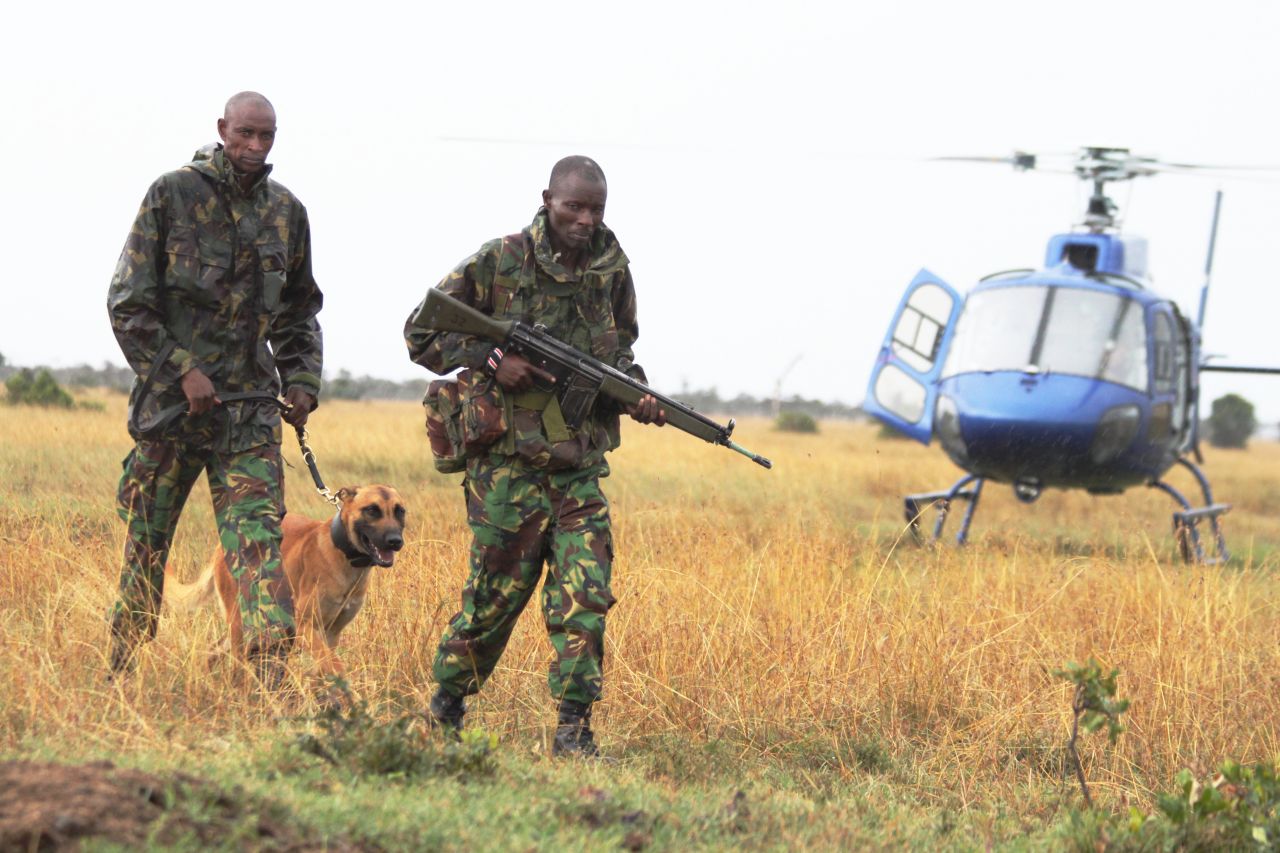
Rangers undertake an anti-poaching drill at Ol Pejeta Conservancy in Kenya. | Credit: Rachel Nuwer
Regardless of the label, many conservationists needed no convincing that saving the northern white rhino was a worthwhile effort, though external factors made that goal difficult to achieve. In the mid-1990s, civil war broke out in Zaire (now the DRC) and the rhinos quickly began to fall. Hillman Smith reported, “Whole groups of elephants were gunned down and more and more rhinos were killed.” Her team identified 30 rhinos in 2003, but by 2004, they could only find 15.
Plans were formulated for trapping and transporting five of the remaining northern whites out of Garamba and into a more secure area where they could be safeguarded for a future reintroduction into the wild. Kenya—though it has suffered its fair share of poaching—has long been a stronghold of conservation and is considered relatively safe compared to many of its neighbors. So in 2005 Hillman Smith and the rest of the rhino community selected Kenya’s Ol Pejeta Conservancy as the relocation site.
Ol Pejeta built new enclosures and readied their staff to welcome the rhinos to its heavily guarded grounds, but permission to trap and transport those animals never arrived.
“Things became mired in politics and never went anywhere,” says Richard Vigne, CEO of Ol Pejeta. In 2006, an intensive aerial survey at Garamba identified just one northern white rhino, but by 2008, none could be found. Later that year, the northern white rhino was declared extinct in the wild.
Salvation by Science
Attention now turned to the handful of northern white rhinos that still existed in captivity around the world. But many were old, and only Dvur Kralove Zoo in the Czech Republic had succeeded at producing calves in captivity. The most recent had been Fatu, Sudan’s granddaughter, born to Najin in 2000. Given the long dry spell following Fatu’s birth, including failed attempts at artificial insemination, the zoo decided to transport four of their six remaining northern white rhinos to Africa. The hope was that being in their natural environment might stimulate their reproduction. Ol Pejeta—already equipped for northern white rhinos and home to numerous black rhinos and southern white rhinoswas the obvious choice. In 2009, the animals were loaded up in the Czech Republic and flown to Kenya.
The new arrivals assimilated well, especially Sudan. The sights, smells and sounds of Africa perhaps stirred decades-old memories. “They took to it like ducks to water,” Vigne says of the former zoo residents. “It was pretty clear that instinct was enough to enable them to adapt very quickly to the environment in which their species had evolved.”
Mating, however, was not part of their new suite of behaviors. Tests revealed that Sudan—at 43, now an old man—had seen much better days in terms of sperm quality. Hildebrandt and his colleagues also discovered that a severe infection had destroyed Fatu’s uterus. Najin, on the other hand, had suffered damage to her Achilles tendons during mating attempts with a southern white rhino bull, leading to a permanently handicapped gait. As Hildebrandt explains, mating with a two-ton bull followed by pregnancy with a 260-pound calf would likely cause Najin’s tendons to permanently rupture.
Even as news of the disappointing mating results at Ol Pejeta spread, Hildebrandt and others had begun talking among themselves about an alternative way to save the subspecies. Those conversations culminated in December 2015, at an official meeting in Vienna titled “Conservation by Cellular Technologies.” There, the researchers formulated a game plan for saving the northern white rhino, which they outlined in a paper published in Zoo Biology.
The approach is two-pronged. The first part entails the creation a test tube baby rhino. Doing this requires figuring out how to safely harvest egg cells from Najin and Fatu. Hildebrant is currently devising such a method by carefully practicing on southern white rhinos kept in zoos in Europe. Dilly-dallying on this task is not an option, given that Fatu and Najin are currently the only depositories of eggs left on the planet. As Vigne put it, “If they die, their eggs die with them.”
As for sperm, Sudan faces no pressure to produce. The Genome Resource Bank in Berlin contains sperm that Hildebrandt and his colleagues collected from four other northern white rhino males. Given that Sudan is Najin and Fatu’s father and grandfather, respectively, his sperm, even if it was viable, risks the problems associated with inbreeding.
Assuming the researchers can successfully unite egg and sperm in a petri dish, the embryo would then be transplanted into the womb of a young, healthy southern white rhino surrogate mother in Kenya. While the procedure is nothing new for cows, pigs and other livestock, it has never been tried in a rhino.
“Rhinos are more similar to a horse, so we’re trying to translate what we do in horses to this species,” says Cesare Galli, director of Avantea, a company based in Cremona, Italy, that specializes in assisted reproduction in large livestock. “We’re not doing this for money, but because it’s worthwhile and could contribute something useful.”
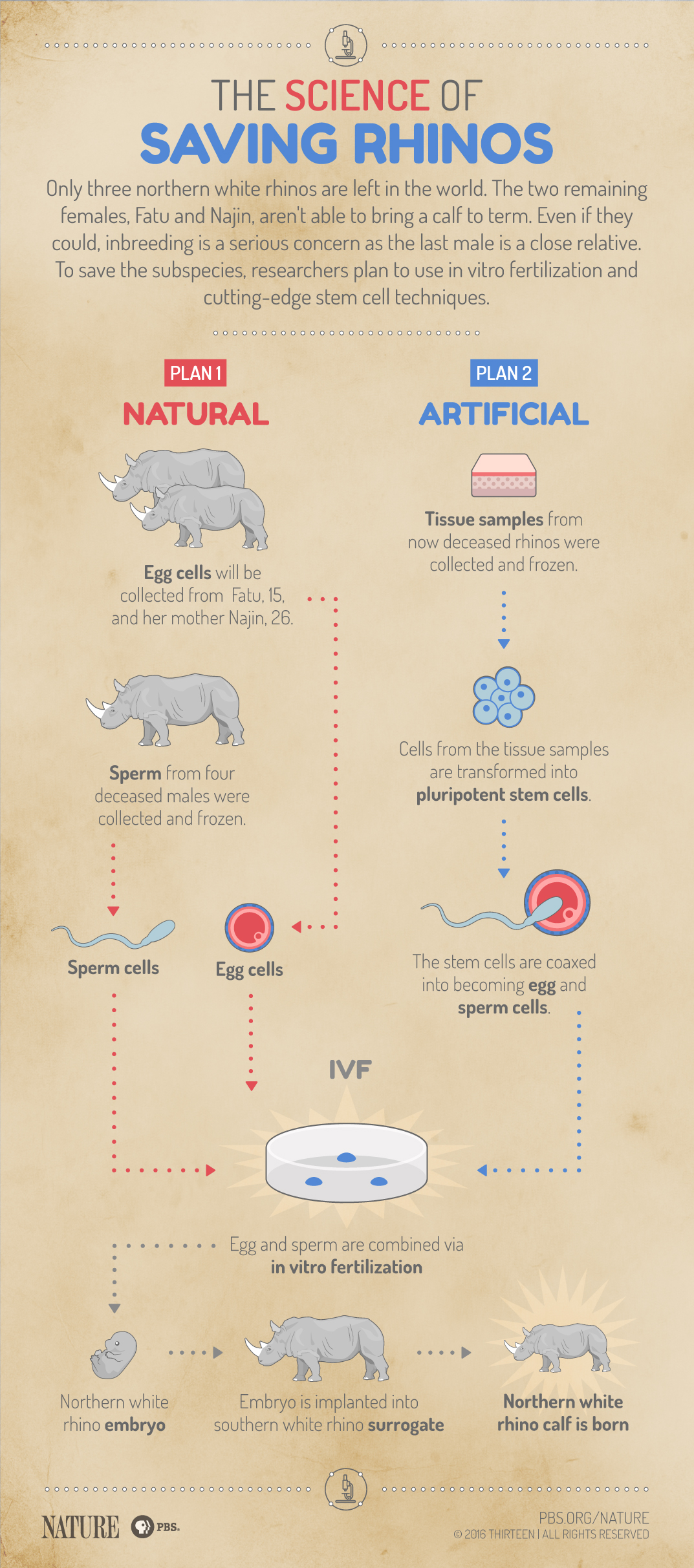
While Hildebrandt and Galli work on the problem of egg collection, in vitro fertilization and implantation, another research team is focusing on solving a separate issue: how to introduce more diversity into the northern white rhino’s gene pool. Even if Najin and Fatu’s eggs are successfully harvested, fertilized and implanted into southern white rhinos, basing an entire species’ recovery on a single mother-daughter pair would provide too narrow a window of genetic variation for creating a healthy population.
The genetic jackpot may reside on yet another continent. In the 1980s, The San Diego Zoo began banking tissue samples from various individuals in its frozen zoo, the world’s largest and most diverse collection of frozen animal samples. The samples include tissue from 12 northern white rhinos, representing eight unrelated individuals.
“We believe there’s enough genetic diversity in the cells we’ve preserved that they could reconstitute a breeding population,” says Oliver Ryder, the San Diego Zoo’s director of genetics.
Tapping into that diversity depends on harnessing the most recent breakthrough technologies in stem cell biology. In 2012, Shinya Yamanaka won the Nobel Prize in Physiology for the discovery that changing the activity of only four genes can imbue a cell with the ability to become any other type of cell in the body. Induced pluripotent stem cells, as they are known, are usually discussed in terms of human health and fertility, but they could also have a conservation application. Indeed, in 2011, a team led by Jeanne Loring, director of the Center for Regenerative Medicine at the Scripps Research Institute, successfully created induced pluripotent stem cells from Fatu’s skin cells.
“Rhino cells are a little harder than human cells to reprogram, but when the method works it really works well,” Loring says. “In fact, my interns are doing this kind of thing now—that’s how straightforward it turned out to be.”
Much remains untested and unproven, including whether induced pluripotent stem cells from northern white rhinos can be turned into viable eggs and sperm. But as Loring says, “There’s no point in being pessimistic about it. It’ll either be easy or hard or really hard.”
Not everyone in the conservation community is so optimistic, however. Some oppose the project, claiming that resurrecting the northern white rhino when it is so close to extinction gives the impression that allowing other animals to approach the brink is an acceptable action plan. Others insist that the northern white rhino work is a waste of time and resources that could be spent on saving other species that are not such an obvious lost cause.
“They should not be pushing this idea that they’re saving a species,” Michael Knight, chair of the International Union for Conservation of Nature’s Rhino Specialist group, told Nature News. “If you want to save a [rhino] species, put your money into southern white conservation.”
Ryder points out, however, that the same type of argument has been made for decades now about the very existence of zoos, and that the San Diego Zoo donors who are backing this project are doing so because they specifically want to prevent the extinction of the northern white rhino. And while the zoo has raised a couple million in funds toward the project, Hildebrandt adds that, at least for his group, “there is no competition about funding because we didn’t get any additional funding.” Instead, the small amount of money he is relying on for the project comes solely from his institution, which invests in reproductive technologies—not classical conservation. Loring is in a similar situation. “We don’t have access to the money used for saving habitats in Africa, we have access to money for developing new stem cell technology,” she says. “It’s not like there’s one pot of money you can spend around.”
Rhinos on the Horizon
For now, the researchers are not putting a timeline on the project; there are simply too many unknowns.
“We don’t know if we will be successful in one, two, three or four or more years, but what we do know is that liquid nitrogen buys us time,” Hildebrandt says. “Theoretical calculations say that a biological sample stored in liquid nitrogen can be sustained for 3,000 years before [it is] destroyed by the earth’s natural radiation, though I hope we can achieve success sooner than that.”
“The timeline we’re giving,” he continued, “is that we want Fatu and Najin to see a calf of their own kind while they are still alive, which means the next 10 years.”
If efforts to bring the northern white rhino back from the brink are successful, they hold the promise of possibility for other rhino species as well. These include the Javan rhino and Sumatran rhino, of which 60 and 100, respectively, are estimated to remain.
“Even if we do not succeed with the northern white rhino, we will definitely gain knowledge that would help other critically endangered species,” Stejskal says.
At the same time, the researchers hope that the well-publicized plight of the rhino raises awareness about other animals that are in danger of extinction.
“The northern white rhino is a signal of what we as humans are doing to the planet,” Vigne says. “What’s happening to this species is also happening to many thousands of species across the planet.”
In that sense, even if the researchers fail and the northern white rhino does go extinct, the project will not have been completely for naught. Regardless of the possibility of failure, they are determined to move forward. “We can acquiesce and say, ‘Ok, too bad, there’s not much we can do,’ or we can ask ourselves if there is something we can do, and then do it,” Ryder says. “I think this project sends a message of hope, and that the future will be glad for all that we pass along.”

